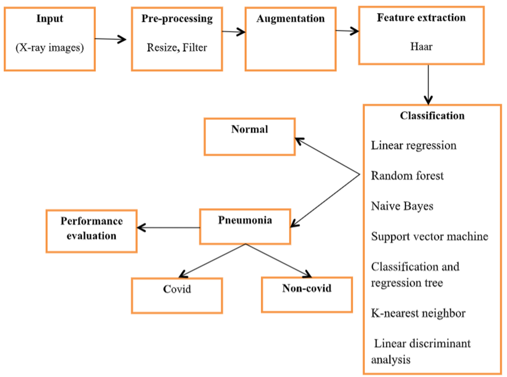A Comparative Study of HARR Feature Extraction and Machine Learning Algorithms for Covid-19 X-Ray Image Classification
Main Article Content
Abstract
In this study, we investigated how effectively COVID-19 image categorization using Harr feature extraction and machine learning algorithms. We were particularly interested in the effectiveness of these algorithms. A dataset of 500 X-ray scans, equally split between 250 COVID-19-positive cases and 250 healthy controls, served as the basis for our study. K-nearest neighbors,decision tree, Linear regression, support vector machine, regression, classification, naive Bayes,random forest, as well as linear discriminant analysis were among the seven machine-learning approaches used to categorize the photos. With the use of Harr feature extraction, the features of the pictures were extracted. We studied the efficacy of COVID-19 X-ray images for classification utilizing the combination of machine learning as well as the Harr feature extraction methods in the present investigation due to their effectiveness. We searched a database of 500 X-rays for this investigation, dividing them equally between groups of 250 patients with COVID-19-positive cases and 250 healthy people. Following that, the images were examined using seven various machine learning approaches for recognition. These methods included naive Bayes, linear discriminant analysis, random forests, classification,k-nearest neighbors, and regression trees. The information from the photos was gathered using the Harr feature extraction method. The effectiveness of the algorithms was evaluated with the help of a variety of metrics, such asF1 score, precision,accuracy, recall, the area under the ROC curve, and the region of interest curve. According to our research, the Support Vector Machine algorithm had the highest accuracy, at 77%, while the Naive Bayes approach had the lowest accuracy, at 58%. By using machine learning and Harr feature extraction approaches, the Random Forest method yields the best results, based on our research. The development of future COVID-19 X-ray image-based automated diagnostic systems may be influenced by these findings. Results from the suggested model were comparable to those of cutting-edge models trained using transfer learning techniques. The proposed model's main advantage is that it has ten times fewer parameters than the most advanced models.A receiver operating characteristic (ROC) curve's F1 score, and the algorithms' accuracy, precision, the area under the curve, and recall were all used as metrics. According to our findings, the Naive Bayes method gained the least accuracy (58%) and the Support Vector Machine method produced the highest accuracy (77%) when used. Our results reveal that employing Harr feature extraction and machine learning techniques, the Random Forest strategy is the most successful way to recognize COVID-19 X-ray pictures. These findings may be pertinent to the development of automated COVID-19 diagnosis tools relying on X-ray images. The recommended model produced results that were competitive when measured against cutting-edge models trained using transfer learning techniques. The suggested model employs 10 times fewer parameters than the most advanced models, which is its key selling point.
Article Details
References
Ahsan, M., Based, M. A., Haider, J., & Kowalski, M. (2021). COVID-19 detection from chest X-ray images using feature fusion and deep learning. Sensors, 21(4), 1480.
Hasoon, J. N., Fadel, A. H., Hameed, R. S., Mostafa, S. A., Khalaf, B. A., Mohammed, M. A., &Nedoma, J. (2021). COVID-19 anomaly detection and classification method based on supervised machine learning of chest X-ray images. Results in Physics, 31, 105045.
Eljamassi, D. F., &Maghari, A. Y. (2020, December). COVID-19 detection from chest X-ray scans using machine learning. In 2020 International Conference on Promising Electronic Technologies (ICPET) (pp. 1-4). IEEE.
Chen, J. I. Z. (2021). Design of accurate classification of COVID-19 disease in X-ray images using deep learning approach. Journal of ISMAC, 3(02), 132-148.
J. Surendiran, & M. Meena. (2023). Deep learning-Assisted Glaucoma Diagnosis and Model Design. International Journal of Intelligent Systems and Applications in Engineering, 11(1), 269–276. Retrieved from https://ijisae.org/index.php/IJISAE/article/view/2467
Khan, N., Ullah, F., Hassan, M. A., & Hussain, A. (2020). COVID-19 classification based on Chest X-Ray images using machine learning techniques. Journal of Computer Science and Technology Studies, 2(2), 01-11.
Subramaniam, U., Subashini, M. M., Almakhles, D., Karthick, A., & Manoharan, S. (2021). An expert system for COVID-19 infection tracking in lungs using image processing and deep learning techniques. BioMed Research International, 2021, 1-17.
Rajpal, S., Agarwal, M., Rajpal, A., Lakhyani, N., Saggar, A., & Kumar, N. (2022). Cov-elm classifier: an extreme learning machine-based identification of covid-19 using chest x-ray images. Intelligent Decision Technologies, 16(1), 193-203.
Ho, T. K. K., &Gwak, J. (2022). Feature-level ensemble approach for COVID-19 detection using chest X-ray images. Plos one, 17(7), e0268430
Jusman, Y., Tyassari, W., Nisrina, D., Santosa, F. G., &Prayitno, N. A. (2022, June). Machine Learning Performances for Covid-19 Images Classification based Histogram of Oriented Gradients Features. In 2022 IEEE International IoT, Electronics and Mechatronics Conference (IEMTRONICS) (pp. 1-6). IEEE.
Mittal, V., & Kumar, A. (2023). COVINet: A hybrid model for classification of COVID and Non-COVID pneumonia in CT and X-Ray imagery. International Journal of Cognitive Computing in Engineering, 4, 149-159.
Tallapragada, V. S., Manga, N. A., & Kumar, G. P. (2023). A novel COVID diagnosis and feature extraction based on discrete wavelet model and classification using X-ray and CT images. Multimedia Tools and Applications, 1-42.
Alkoot, F. M., Alkhedher, H. M., &Alkoot, Z. F. (2023). Experimental analysis of machine learning methods to detect Covid-19 from x-rays. Journal of Engineering Research, 100063.

